The global technical films market is valued at USD 142.6 billion in 2025 and is projected to reach USD 319.5 billion by 2035, representing an absolute increase of USD 176.9 billion over the forecast period. This translates into a total growth of 123.3%, with the market forecast to expand at a CAGR of 8.4% between 2025 and 2035. The market size is expected to grow by nearly 2.23 times during the same period, supported by increasing demand for flexible electronics, the growing adoption of high-barrier packaging solutions in the pharmaceutical and food industries, and a rising preference for lightweight materials across automotive and aerospace applications.
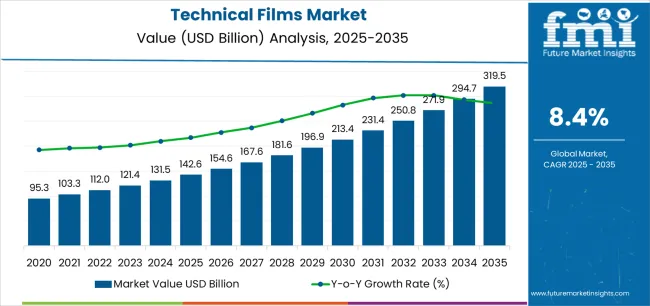
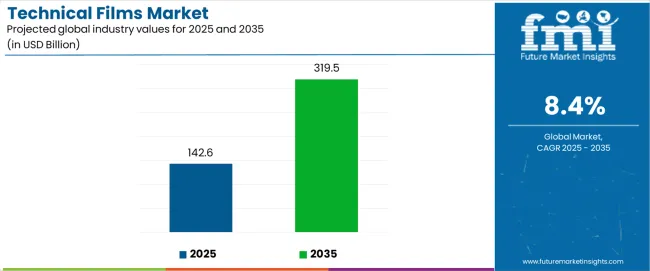
Between 2025 and 2030, the technical films market is projected to expand from USD 142.6 billion to USD 214.8 billion, resulting in a value increase of USD 72.2 billion, which represents 41.1% of the total forecast growth for the decade. The increasing miniaturization of electronics will shape this phase of development, the rising adoption of advanced coating technologies, and the growing demand for high-performance barrier films in sensitive product packaging. Electronics manufacturers are expanding their technical film sourcing capabilities to address the growing demand for flexible displays, touch sensors, and advanced insulation materials.
| Metric | Value |
|---|---|
| Estimated Value in (2025E) | USD 142.6 billion |
| Forecast Value in (2035F) | USD 319.5 billion |
| Forecast CAGR (2025 to 2035) | 8.4% |
The packaging market is the largest contributor, accounting for approximately 35-40% of the market. Technical films are widely used for protective packaging applications in industries such as food, electronics, and pharmaceuticals, where high-performance films are required to provide barriers to moisture, gases, UV rays, and physical damage. The electronics market adds about 20-25%, as technical films are used in the production of displays, touchscreens, and other electronic components. These films offer enhanced durability, optical clarity, and resistance to scratching, which are essential for the performance and longevity of electronic devices.
The automotive market contributes around 15-18%, where technical films are employed for applications such as window tinting, interior coatings, and protective films for vehicle surfaces. These films help improve vehicle aesthetics, provide UV protection, and enhance fuel efficiency by reducing heat buildup inside vehicles. The solar energy market represents about 12-15%, with technical films being used in solar panels to improve energy efficiency, enhance durability, and protect the panels from environmental elements. The medical device market accounts for approximately 8-10%, as technical films are used for sterilization wraps, wound care products, and medical packaging, offering both protective and functional properties.
Market expansion is being supported by the increasing global demand for electronic devices and the corresponding need for high-performance materials that can enable miniaturization, improve product reliability, and provide superior barrier properties across various industrial applications. Modern electronics manufacturers are increasingly focused on implementing material solutions that can support flexible form factors, enhance thermal management, and provide consistent performance in demanding operational environments. Technical films' proven ability to deliver exceptional mechanical properties, optical clarity, and chemical resistance make them essential materials for contemporary electronics production and advanced packaging solutions.
The growing emphasis on energy efficiency and lightweight construction is driving demand for technical films that can support automotive weight reduction, improve solar panel efficiency, and enable advanced building envelope systems. Manufacturers' preference for materials that combine high performance with processing efficiency and design flexibility is creating opportunities for innovative technical film implementations. The rising influence of electric vehicle adoption and renewable energy expansion is also contributing to increased demand for technical films that can provide electrical insulation, thermal management, and protective barrier functions.
The technical films market is poised for rapid growth and transformation. As industries across electronics, automotive, packaging, medical devices, and renewable energy seek materials that deliver exceptional performance, durability, and processing advantages, technical films are gaining prominence not just as commodity materials but as strategic enablers of innovation and product differentiation.
Rising electronics consumption in Asia-Pacific and expanding automotive electrification globally amplify demand, while manufacturers are leveraging innovations in coating technologies, multilayer structures, and functional film development.
Pathways like specialty coatings, advanced barrier properties, and application-specific customization promise strong margin uplift, especially in high-value segments. Geographic expansion and vertical integration will capture volume, particularly where local manufacturing capabilities and supply chain proximity are critical. Regulatory pressures around electronics recycling, automotive emissions, pharmaceutical packaging integrity, and renewable energy performance give structural support.
The market is segmented by material type, application, end use industry, technology, and region. By material type, the market is divided into polyester (PET/BOPET), polyamide (nylon), polycarbonate, fluoropolymers, and others. By application, it covers electronics & electrical, packaging, automotive & transportation, construction, and medical & pharmaceutical. By end use industry, it is segmented into consumer electronics, industrial manufacturing, healthcare, automotive, and others. The technology includes cast film, blown film, and oriented film. Based on thickness, the market is categorized into ultra-thin (<25 microns), thin (25-100 microns), and thick (>100 microns). By distribution channel, the market includes direct sales, distributors, and online channels. Regionally, the market is divided into North America, Europe, East Asia, South Asia & Pacific, Latin America, and the Middle East & Africa.
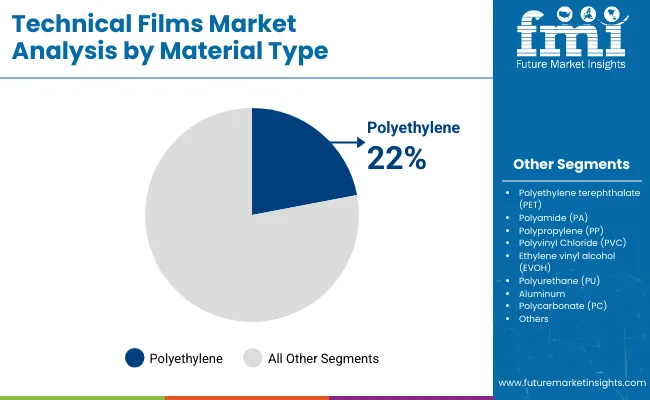
The polyester films segment is projected to account for 38% of the technical films market in 2025, reaffirming its position as the leading material category. Electronics manufacturers increasingly utilize polyester films for their superior dimensional stability, excellent electrical insulation properties, and cost-effectiveness in applications ranging from flexible printed circuits to display components. Polyester film technology's advanced processing capabilities and consistent quality output directly address the industrial requirements for reliable performance and operational efficiency in high-volume production environments.
This material segment forms the foundation of modern electronics manufacturing operations, as it represents the film type with the greatest versatility and established market demand across multiple application categories and industry sectors. Manufacturer investments in enhanced production technologies and surface treatment capabilities continue to strengthen adoption among electronics producers. With companies prioritizing thermal resistance and mechanical durability, polyester films align with both technical performance requirements and cost optimization objectives, making them the central component of comprehensive material strategies.
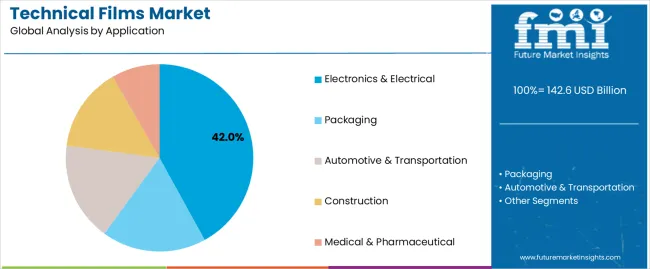
Electronics & electrical applications are projected to represent 42% of technical film demand in 2025, underscoring their critical role as the primary industrial consumers of specialized film materials for electronic device manufacturing and electrical system components. Electronics manufacturers prefer technical films for their exceptional dielectric properties, thermal management capabilities, and ability to enable miniaturization while maintaining product reliability. Positioned as essential materials for modern electronics production, technical films offer both performance advantages and design flexibility benefits.
The segment is supported by continuous innovation in display technologies and the growing availability of specialized coating processes that enable premium film production with enhanced optical properties and surface characteristics. The electronics manufacturers are investing in supply chain partnerships to support large-volume material procurement and quality assurance. As flexible electronics demand becomes more prevalent and device miniaturization requirements increase, electronics & electrical applications will continue to dominate the end-use market while supporting advanced material utilization and product innovation strategies.
The technical films market is advancing rapidly due to increasing demand for miniaturized electronics and growing adoption of high-performance materials that provide superior barrier properties and dimensional stability across diverse industrial applications. The market faces challenges, including raw material price volatility, stringent quality requirements for critical applications, and the need for specialized processing equipment investments. Innovation in coating technologies and functional film development continues to influence product development and market expansion patterns.
The growing adoption of plasma coating, vacuum metallization, and nano-coating technologies is enabling film manufacturers to produce premium technical films with superior barrier properties, enhanced optical characteristics, and specialized surface functionalities. Advanced coating systems provide improved product performance while allowing more efficient processing and consistent output across various film types and applications. Manufacturers are increasingly recognizing the competitive advantages of advanced coating capabilities for product differentiation and premium market positioning.
Modern technical film producers are incorporating electrochromic properties, embedded sensors, and responsive characteristics to enhance product functionality, enable new applications, and deliver value-added solutions to end users. These technologies improve application versatility while enabling new market segments, including smart windows, interactive displays, and adaptive insulation systems. Advanced functional integration also allows manufacturers to support premium product positioning and application development beyond traditional passive film supply.
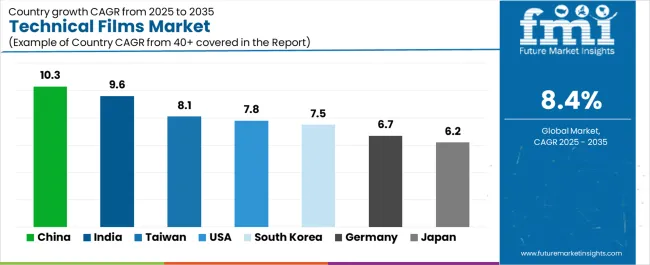
| Country | CAGR (2025-2035) |
|---|---|
| China | 10.3% |
| India | 9.6% |
| USA | 7.8% |
| South Korea | 7.5% |
| Germany | 6.7% |
| Japan | 6.2% |
| Taiwan | 8.1% |
The technical films market is experiencing strong growth globally, with China leading at a 10.3% CAGR through 2035, driven by the expanding electronics manufacturing sector, growing automotive electrification, and significant investment in display panel production infrastructure development. India follows at 9.6%, supported by rapid electronics assembly growth, increasing pharmaceutical packaging requirements, and growing domestic manufacturing capabilities. The USA shows growth at 7.8%, emphasizing advanced coating technology innovation and specialty film development. South Korea records 7.5%, focusing on display technology leadership and semiconductor packaging applications. Germany demonstrates 6.7% growth, prioritizing automotive applications and industrial manufacturing excellence. Japan exhibits 6.2% growth, emphasizing precision manufacturing and quality film production. Taiwan shows 8.1% growth, supported by semiconductor industry demand and display manufacturing concentration.
The report covers an in-depth analysis of 40+ countries, with top-performing countries highlighted below.
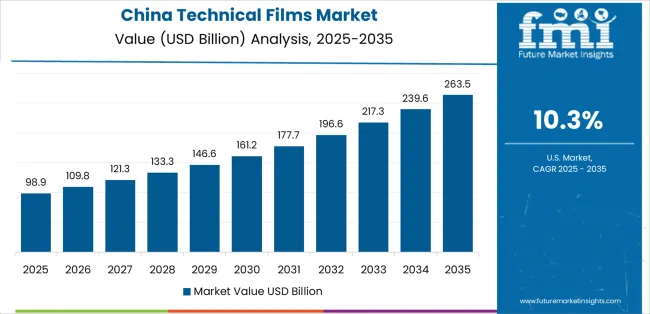
Revenue from technical films in China is projected to exhibit exceptional growth with a CAGR of 10.3% through 2035, driven by expanding electronics manufacturing capacity and rapidly growing display panel production supported by government initiatives promoting domestic supply chain development. The country's dominant position in global electronics assembly and increasing investment in advanced materials are creating substantial demand for high-performance film solutions. Major electronics manufacturers and display producers are establishing comprehensive technical film sourcing capabilities to serve both domestic production and global supply chains.
Demand for technical films in India is expanding at a CAGR of 9.6%, supported by the country's growing electronics assembly sector, expanding pharmaceutical manufacturing capacity, and increasing adoption of advanced packaging solutions. The country's government initiatives promoting domestic manufacturing and growing consumer electronics demand are driving requirements for sophisticated technical film capabilities. International suppliers and domestic manufacturers are establishing extensive production and distribution capabilities to address the growing demand for technical film products.
Revenue from technical films in the USA is growing at a CAGR of 7.8%, supported by the country's advanced materials science capabilities, strong emphasis on specialty film development, and robust demand for high-performance materials in aerospace and medical applications. The nation's mature manufacturing sector and high-value application focus are driving sophisticated technical film capabilities throughout the supply chain. Leading manufacturers and technology providers are investing extensively in advanced coating technologies and functional film development to serve both domestic and export markets.
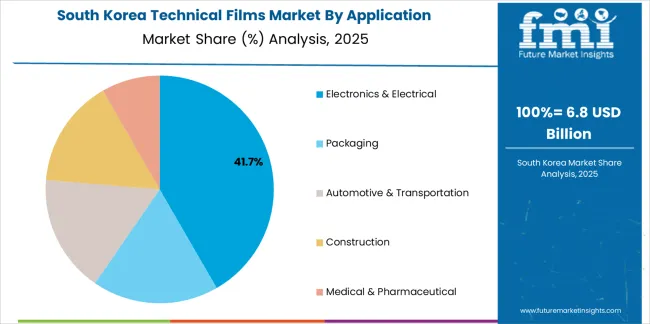
Demand for technical films in South Korea is anticipated to expand at a CAGR of 7.5%, driven by the country's leadership in display panel manufacturing, expanding semiconductor packaging requirements, and growing investment in advanced materials development. South Korea's concentration of major electronics conglomerates and commitment to technology innovation are supporting demand for cutting-edge technical film solutions across multiple high-value segments. Manufacturers are establishing comprehensive research and production capabilities to maintain technological leadership in key application areas.
Revenue from technical films in Germany is expected to expand at a CAGR of 6.7%, supported by the country's automotive industry leadership, advanced manufacturing capabilities, and strategic focus on high-quality specialty films. Germany's engineering excellence and automotive innovation are driving demand for technical films in electric vehicle components, interior trim applications, and advanced glazing systems. Manufacturers are investing in comprehensive development capabilities to serve both domestic automotive producers and international specialty markets.
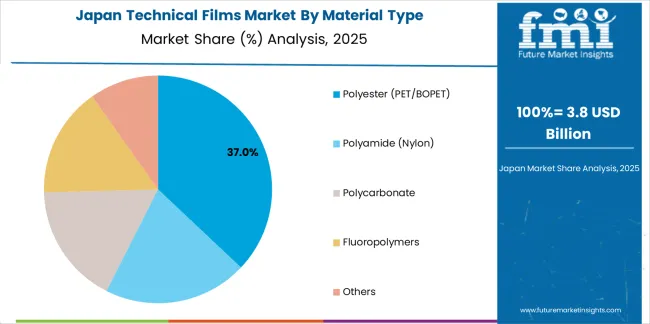
Revenue from technical films in Japan is growing at a CAGR of 6.2%, driven by the country's expertise in precision manufacturing, emphasis on quality control, and strong position in specialty optical films and electronic materials. Japan's established materials science capabilities and commitment to continuous improvement are supporting investment in advanced production technologies throughout major manufacturing centers. Industry leaders are establishing comprehensive quality management systems to serve domestic electronics producers and global specialty markets.
Revenue from technical films in Taiwan is expanding at a CAGR of 8.1%, supported by the country's semiconductor manufacturing concentration, growing display panel production, and strategic position in global electronics supply chains. Taiwan's advanced semiconductor packaging capabilities and integrated manufacturing ecosystem are driving demand for high-performance technical films in wafer processing, chip packaging, and display assembly applications. Leading manufacturers are investing in specialized capabilities to serve the stringent requirements of semiconductor and display industries.

The technical films market in Europe is projected to grow from USD 31.8 billion in 2025 to USD 69.2 billion by 2035, registering a CAGR of 8.1% over the forecast period. Germany is expected to maintain its leadership position with a 32.0% market share in 2025, declining slightly to 31.5% by 2035, supported by its strong automotive industry, advanced materials manufacturing capabilities, and comprehensive industrial base serving diverse technical film applications across Europe.
France follows with a 16.0% share in 2025, projected to reach 16.3% by 2035, driven by robust demand for technical films in aerospace applications, pharmaceutical packaging, and automotive components, combined with established materials science capabilities and specialty film production expertise. The United Kingdom holds a 14.0% share in 2025, expected to maintain 14.0% through 2035, supported by strong pharmaceutical manufacturing and growing electronics assembly activities. Italy commands a 12.0% share in 2025, projected to reach 12.2% by 2035, while Spain accounts for 8.0% in 2025, expected to reach 8.3% by 2035. The Netherlands maintains a 4.5% share in 2025, growing to 4.7% by 2035. The Rest of Europe region, including Nordic countries, Eastern Europe, Belgium, Switzerland, Austria, and Poland, is anticipated to gain momentum, expanding its collective share from 13.5% to 13.0% by 2035, attributed to increasing electronics manufacturing in Eastern Europe and growing specialty applications in Nordic countries implementing advanced manufacturing programs.

The technical films market is characterized by competition among established chemical companies, specialized film manufacturers, and integrated materials producers. Companies are investing in advanced extrusion technology research, coating process optimization, quality control systems, and comprehensive product portfolios to deliver consistent, high-performance, and application-specific technical film solutions. Innovation in multilayer film structures, functional coatings, and bio-based materials is central to strengthening market position and competitive advantage.
Toray Industries leads the market with a strong market share, offering comprehensive polyester and polyamide film solutions with a focus on electronics applications and display materials. DuPont provides specialized fluoropolymer and high-performance film capabilities with an emphasis on demanding industrial applications. 3M Company delivers innovative film products with a focus on optical films and functional adhesive solutions. Mitsubishi Chemical specializes in polyester films and specialty barrier materials for packaging and electronics markets. Covestro AG focuses on polycarbonate films and advanced coating technologies. Amcor plc offers specialized packaging films with emphasis on barrier properties and pharmaceutical applications.
| Items | Values |
|---|---|
| Quantitative Units (2025) | USD 142.6 billion |
| Material Type | Polyester (PET/BOPET), Polyamide (Nylon), Polycarbonate, Fluoropolymers, Others |
| Application | Electronics & Electrical, Packaging, Automotive & Transportation, Construction, Medical & Pharmaceutical |
| End Use Industry | Consumer Electronics, Industrial Manufacturing, Healthcare, Automotive, Others |
| Technology | Cast Film, Blown Film, Oriented Film |
| Thickness | Ultra-thin (<25 microns), Thin (25-100 microns), Thick (>100 microns) |
| Distribution Channel | Direct Sales, Distributors, Online Channels |
| Regions Covered | North America, Europe, East Asia, South Asia & Pacific, Latin America, Middle East & Africa |
| Countries Covered | United States, Canada, United Kingdom, Germany, France, China, Japan, South Korea, India, Taiwan, Brazil, Australia and 40+ countries |
| Key Companies Profiled | Toray Industries, DuPont, 3M Company, Mitsubishi Chemical, Covestro AG, and Amcor plc |
| Additional Attributes | Dollar sales by material type and application category, regional demand trends, competitive landscape, technological advancements in coating systems, functional film development, bio-based materials innovation, and supply chain integration |
The global technical films market is estimated to be valued at USD 142.6 billion in 2025.
The market size for the technical films market is projected to reach USD 319.5 billion by 2035.
The technical films market is expected to grow at a 8.4% CAGR between 2025 and 2035.
The key product types in technical films market are polyester (pet/bopet), polyamide (nylon), polycarbonate, fluoropolymers and others.
In terms of application, electronics & electrical segment to command 42.0% share in the technical films market in 2025.






Full Research Suite comprises of:
Market outlook & trends analysis
Interviews & case studies
Strategic recommendations
Vendor profiles & capabilities analysis
5-year forecasts
8 regions and 60+ country-level data splits
Market segment data splits
12 months of continuous data updates
DELIVERED AS:
PDF EXCEL ONLINE
Analyzing Technical Films Market Share & Industry Leaders
Technical Insulation Market Size and Share Forecast Outlook 2025 to 2035
Technical Textile Production Equipment Market Size and Share Forecast Outlook 2025 to 2035
Technical Coil Coatings Market Growth 2025 to 2035
Technical Textiles Market Growth - Trends & Forecast 2025 to 2035
Technical Fluids Market
Technical Enzymes Market Outlook – Growth, Demand & Forecast 2020 to 2030
Geotechnical Instrumentation And Monitoring Market Size and Share Forecast Outlook 2025 to 2035
TPE Films and Sheets Market Size and Share Forecast Outlook 2025 to 2035
Breaking Down PCR Films Market Share & Industry Positioning
PCR Films Market Analysis by PET, PS, PVC Through 2035
LDPE Films Market
Card Films Market
Mulch Films Market Size and Share Forecast Outlook 2025 to 2035
Nylon Films for Liquid Packaging Market from 2024 to 2034
Vinyl Films Market
MDO-PE Films Market Analysis by Cast Films and Blown Films Through 2035
Edible Films and Coatings Market Growth - Trends & Forecast 2025 to 2035
Market Share Breakdown of Edible Films and Coatings
Retort Films Market

Thank you!
You will receive an email from our Business Development Manager. Please be sure to check your SPAM/JUNK folder too.
Chat With
MaRIA